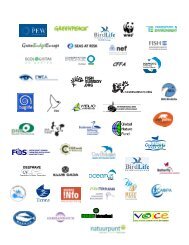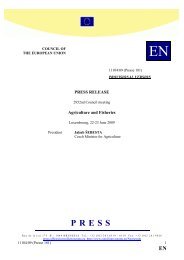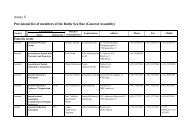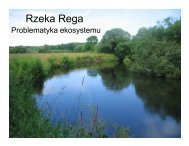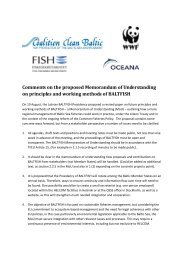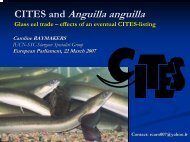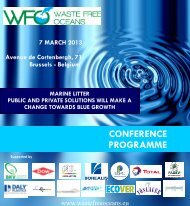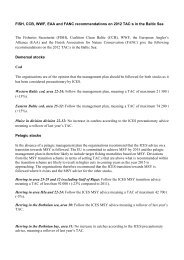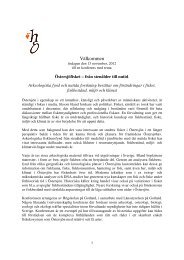A report on iUU fishing of Baltic Sea cod - Fisheries Secretariat
A report on iUU fishing of Baltic Sea cod - Fisheries Secretariat
A report on iUU fishing of Baltic Sea cod - Fisheries Secretariat
Create successful ePaper yourself
Turn your PDF publications into a flip-book with our unique Google optimized e-Paper software.
Number <strong>of</strong> employees in the fish processingsector in DenmarkType <strong>of</strong> company 1996 1997 1998 1999 2000Smoking and drying 1,512 1,913 1,568 1,578 1,704Canning and filleting 6,473 5,220 5,251 4,962 4,859Fish meal and fish oil 603 499 488 472 424Wholesale trade 3,237 3,399 3,292 3,099 3,060Retail trade 909 901 955 998 1,048Total 19,612 18,293 17,771 17,285 17,449Source: adapted from FAO, 2004The table below provides a breakdown <strong>of</strong> thecategories and number <strong>of</strong> vessels within the Swedishfleet.Category <strong>of</strong> registered vesselNumberPelagic trawler (≥ 24m) 55Pelagic trawler (< 24 m) 63Demersal trawler (<strong>cod</strong>, ≥ 24 m)6Demersal trawler (<strong>cod</strong>, < 24 m) 73Gill netters/l<strong>on</strong>gliners (≥ 12 m)9Gill netters/l<strong>on</strong>gliners (< 12m)79Shrimp trawler 60Nephrops trawler 90TOTAL 685SWEDENFor Sweden, the <strong>Baltic</strong> <strong>Sea</strong> is the most important<strong>fishing</strong> area with 45% <strong>of</strong> total nati<strong>on</strong>al landingsin volume. Other important <strong>fishing</strong> areas includethe Skagerrak (15%), the Kattegat (6%), theNorth <strong>Sea</strong> (12%) and the North Atlantic (23%)(FAO, 2004a).The <strong>fishing</strong> sector in Sweden is decreasing – landings(value as well as quantity), vessel numbersand numbers <strong>of</strong> fishermen are all decreasing. Atthe same time, the prices <strong>of</strong> fish for c<strong>on</strong>sumpti<strong>on</strong>have increased, the amount <strong>of</strong> fish used forreducti<strong>on</strong> has declined and exports <strong>of</strong> fish andfishery products have increased (OECD, 2005a).The overall c<strong>on</strong>tributi<strong>on</strong> <strong>of</strong> the fisheries sector tothe ec<strong>on</strong>omy is small – about 0.2%. On the westcoast, where large processing facilities are based,the ec<strong>on</strong>omic importance is more significant(FAO, 2004a).There are approximately 1,860 fishermen (FAO,2004a) and 685 vessels with a total gross t<strong>on</strong>nage<strong>of</strong> 41,700 (ICES, 2005). The fleet segmentshave differing capacities for adapting to changesin <strong>fishing</strong> possibilities. The smaller boats usuallyfish from a local port, whereas the mobility <strong>of</strong>larger vessels enables them to move between<strong>fishing</strong> grounds and land in other <strong>Baltic</strong> States.There are a large number <strong>of</strong> landing sites inSweden. The most important are the harbours<strong>of</strong> Träslövsläge, Göteborg, Ängholmen, Smögen,and Strömstad <strong>on</strong> the west coast; and Trelleborg,Simrishamn, Karlskr<strong>on</strong>a, Nogersund, Västervik,and Oxelösund in the <strong>Baltic</strong>. Several Danish harbours,such as Skagen and Hanstholm, are alsoimportant for landing Swedish catches (FAO,2004a).Source: ICES, 2005The pelagic fisheries are c<strong>on</strong>ducted by four fleetcategories:(i)(ii)(iii)(iv)Trawlers catching herring for human c<strong>on</strong>sumpti<strong>on</strong>.Trawlers catching sprat, some <strong>of</strong> whichis used for human c<strong>on</strong>sumpti<strong>on</strong> but themajority is used for industrial purposes.Herring is caught as bycatch in this fishery.Coastal gillnet fishery for herring for humanc<strong>on</strong>sumpti<strong>on</strong>.Purse seine fishery near the coast for spawningherring in the sec<strong>on</strong>d quarter <strong>of</strong> theyear. This fishery is also for human c<strong>on</strong>sumpti<strong>on</strong>(FAO, 2004a).The demersal fishery for <strong>cod</strong> and flatfish in the<strong>Baltic</strong> is carried out by four fleet categories:(i)(ii)(iii)(iv)Trawlers targeting <strong>cod</strong> but with a bycatch<strong>of</strong> flatfish;Gillnetters and l<strong>on</strong>gliners targeting <strong>cod</strong>but with a bycatch <strong>of</strong> flatfish (l<strong>on</strong>glines arestarting to increase <strong>on</strong> the behalf <strong>of</strong> gillnettersin this category, possibly caused by theneed for improved quality which deterioratesmore so with the soak time <strong>of</strong> nets)(ICES, 2005)Gillnetters targeting flatfish but with abycatch <strong>of</strong> <strong>cod</strong>.Coastal fishery with trap nets for eel andother species. Cod and flatfish are caughtin this fishery (FAO, 2004a).The large pelagic vessels accounted for morethan 40% <strong>of</strong> the total nati<strong>on</strong>al landings in terms<strong>of</strong> value and close to 90% <strong>of</strong> the landed volumein 2003 (FAO, 2004a). EU rules governing the– 53 –



